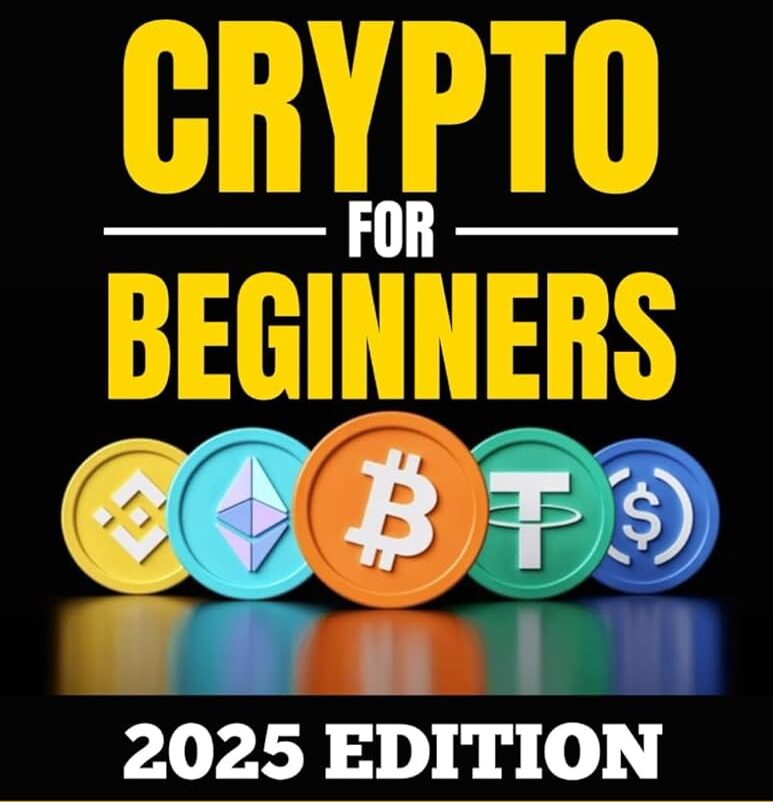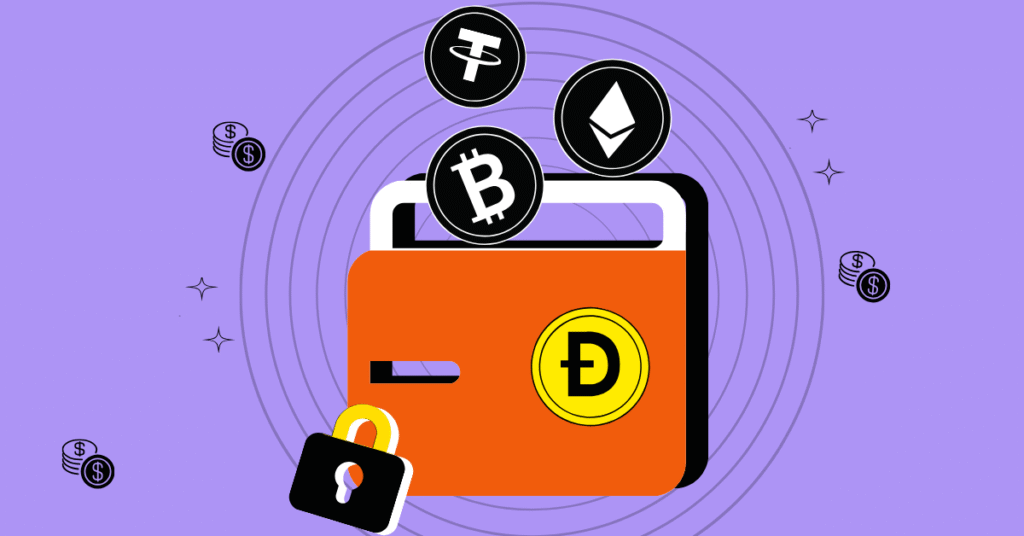Crypto for Beginners (2025): Simple, No-Hype Guide to Buying, Storing & Staying Safe
Start here: what crypto is, how to buy your first coins, which wallet to use, how fees work, and 12 safety rules every beginner should know. Written for real people—clear, practical, and risk-aware.

Crypto, explained in 3 minutes
Cryptocurrency is digital money running on open networks called blockchains. Transactions are verified by a distributed network (validators) instead of a bank. You control funds with a private key tied to a public address.
- Bitcoin (BTC): decentralized digital cash with a fixed supply.
- Ethereum (ETH): programmable money with smart contracts and apps.
- Wallet: software/hardware that stores your key and signs transactions.
Picture this: a public spreadsheet (blockchain) everyone can verify; your wallet “signs” to move value—no banker in the middle.
Is crypto right for beginners? Risk, returns, and mindset
- Volatile: price can swing double-digits within days. Start small.
- Asymmetric: small allocations can matter—never use rent money.
- Time horizon: think in years; avoid leverage at the start.
- Learn-by-doing: a $25 test buy teaches more than weeks of reading.
Winning mindset: curiosity, patience, and strict risk controls.
Step-by-step: buy your first crypto (the safe way)
- Choose a reputable exchange (see picks below).
- Verify & enable 2FA (authenticator app, not SMS).
- Deposit via bank transfer (usually cheaper than card).
- Place a small order (market/limit) for BTC or ETH.
- Optional: withdraw to a wallet you control for longer holds.
- Record the transaction (CSV/PDF) for taxes.
| Step | Why it matters | Pro tip |
|---|---|---|
| Pick exchange | Security, fees, support | Check incident history & PoR reports |
| KYC + 2FA | Prevents account takeovers | Use an authenticator app; add security keys if supported |
| Deposit | Lower fees, fewer reversals | Test a small amount to learn timings |
| Buy | Own your first crypto | Prefer limit orders during high volatility |
| Withdraw | Self-custody for long-term | Send a tiny test before full transfer |
| Record | Tax & audit trail | Save receipts/CSVs from day one |

Picking an exchange: beginner-friendly options
Choose based on safety, fees, ease of use, and asset access. Here are neutral, practical picks:
| Exchange | Best for | Highlights | Start |
|---|---|---|---|
| Coinbase | First purchase | Clean UX, strong compliance & reporting | Get started → |
| Kraken | Security-first | Long track record, robust support, pro tools later | Visit |
| Binance | Low fees, deep liquidity | Huge markets; verify regional availability | Join Binance → |
| OKX | CeFi + Web3 | Integrated wallet & DEX routes; competitive pricing | Try OKX → |
| Bybit | Futures later (not day-1) | Derivatives powerhouse—start with spot only | Explore → |
Compare more inside the Affmiss Crypto Hub.
Wallets 101: custodial vs non-custodial
Custodial (on exchange): easiest; the platform holds your keys—fine for first buys/trades. Non-custodial: you hold a seed phrase and control the keys—best for larger/long-term balances.
- Mobile non-custodial: quick to set up; good for small/medium.
- Browser extension: connects to dApps; beware phishing.
- Hardware wallet: keys offline; ideal once holdings grow.
| Wallet type | Control | Difficulty | Best use |
|---|---|---|---|
| Custodial (exchange) | Low | Very easy | First buy, tiny balances |
| Mobile non-custodial | High | Easy | Daily use, small/medium |
| Hardware wallet | Highest | Moderate | Long-term, larger balances |

Fees & networks: pay less, move smarter
- Trading fees: maker/taker tiers.
- Spread: gap between buy and sell quotes.
- Network fees: on-chain transaction costs.
- Withdrawal fees: fixed or dynamic by asset/network.
Tips: prefer bank transfer; consider low-fee networks (L2) for small transfers; batch fewer, larger withdrawals; learn limit orders.
12 safety rules most beginners skip (don’t)
- Enable 2FA (authenticator app) on day one.
- Use a unique password with a manager.
- Whitelist withdrawal addresses (where supported).
- Send a $5 test before bigger transfers.
- Back up seed phrase offline (paper/steel)—never cloud/email.
- Never share seed/private key—even with “support”.
- Bookmark official sites; beware phishing & fake apps.
- Double-check contract addresses before DEX buys.
- Avoid “guaranteed” returns & shady airdrops.
- No leverage until months of experience.
- Diversify counterparty risk: don’t park everything in one place.
- Keep a simple log of buys/sells/fees for taxes.
Starter portfolio & simple strategies (DCA, diversify)
Common beginner setup:
- Core (70–90%): BTC/ETH split (e.g., 60/40 or 50/50).
- Satellite (10–30%): 1–3 large-cap alts you actually researched.
- Stablecoin buffer (5–10%): dry powder for dips.
DCA: buy a small, fixed amount weekly/bi-weekly to reduce timing risk. Rebalance quarterly back to your targets.
Reminder: futures, margin, and options are not for day-1. Master spot first.
Taxes & tracking (keep it clean)
- Crypto may be taxable (capital gains, income from staking/airdrops).
- Export CSVs from exchanges; tag transfers vs trades.
- Use a portfolio tracker/tax tool; consult a local professional when unsure.
- Keep receipts (PDFs) and note fees—they affect cost basis.
Glossary you’ll actually use
- Blockchain: public ledger for transactions.
- Private key / seed phrase: proof of ownership; never share.
- Wallet: app/device that holds keys and signs transactions.
- Exchange (CEX): marketplace to buy/sell with fiat.
- Stablecoin: token tracking a stable value (e.g., USD).
- Gas/fees: cost to process a transaction on-chain.
- DCA: fixed-amount buying to smooth volatility.
Classic beginner mistakes (and the fix)
- FOMO buys after huge pumps → Fix: DCA + rules.
- All-in one coin → Fix: core BTC/ETH, limit alts.
- Ignoring fees → Fix: bank transfers, L2 networks, batch withdrawals.
- One platform only → Fix: distribute across venues; learn self-custody.
- Leverage too early → Fix: master spot first; size positions conservatively.
Your 30-day starter plan
Week 1 – Learn the ropes
- Skim this guide + the Affmiss Crypto Hub.
- Pick an exchange (Coinbase/Kraken/Binance/OKX).
- Create account, complete KYC, enable 2FA, set withdrawal whitelist.
Week 2 – First purchase
- Deposit $25–$100 (bank transfer preferred).
- Place your first BTC/ETH order; save receipt/CSV.
- Optional: set up a mobile non-custodial wallet; do a $5 test withdraw.
Week 3 – Build routine
- Start a small weekly DCA.
- Read one security guide; back up seed phrase on paper/steel.
Week 4 – Tighten the system
- Add a second venue (e.g., OKX or Binance) for liquidity diversity.
- Set portfolio targets (e.g., 70% BTC/ETH, 30% large-cap alts).
- Create a quarterly rebalance rule and simple risk limits.
Subtle CTAs (affiliates & internal): Coinbase • Binance • OKX • Bybit • more in the Affmiss Crypto Hub.
Risk reminder: Crypto is volatile. No returns are guaranteed. Never invest funds you cannot afford to lose.
FAQ
Is crypto safe for absolute beginners?
Yes—if you enable 2FA, start small, avoid leverage early, and learn wallets before moving big sums.
What’s the best first coin for beginners?
Most start with BTC or ETH due to liquidity and abundant learning resources.
Should beginners keep crypto on an exchange?
Exchanges are convenient for buying and small balances. For larger/long-term storage, use a non-custodial wallet and back up your seed offline.
How much should I invest at first?
Only what you can afford to lose. Many beginners use $10–$50 DCA weekly/bi-weekly.
Which exchange is best for beginners?
Coinbase/Kraken for simplicity and support; Binance/OKX for lower fees and deeper markets once you’re comfortable.
